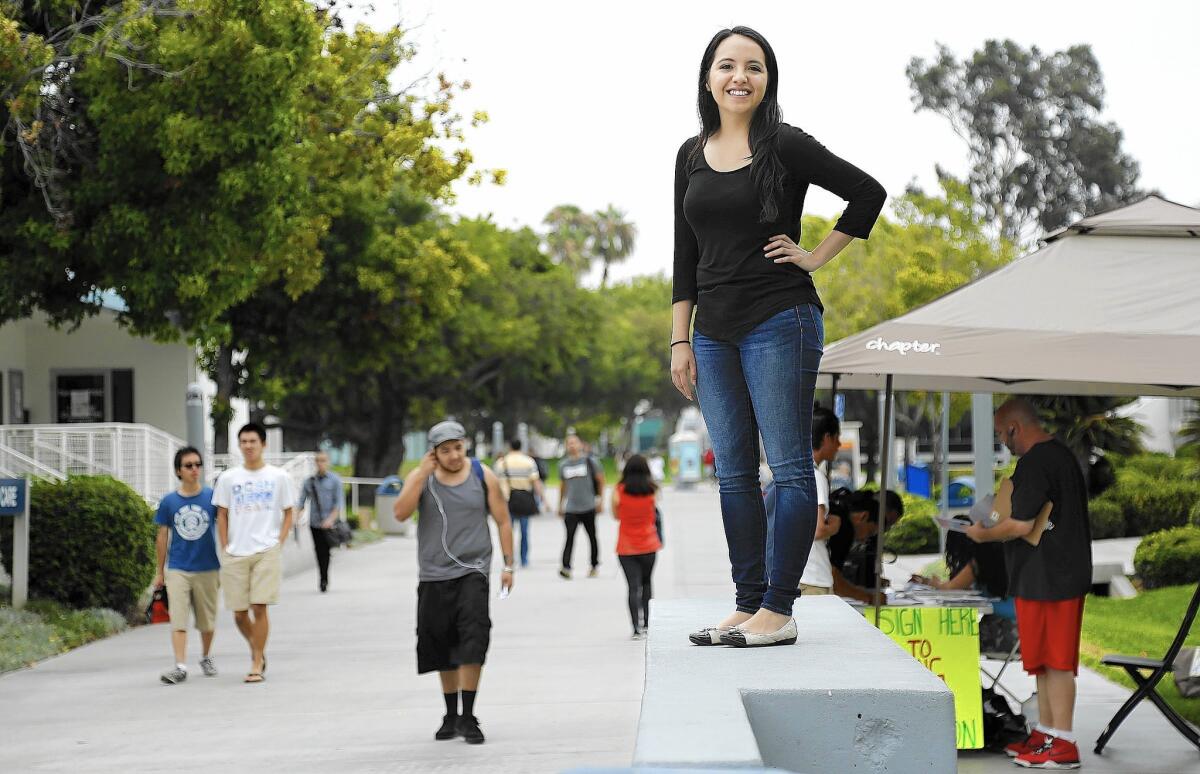Higher Learning: Cerritos College a model of boosting Latino students’ success, study finds

Michelle Mancilla, 20, a student at Cerritos College in Norwalk, plans to transfer to Cal State Fullerton in fall 2016. Cerritos College has increased the rate of success of its Latino students.
Michelle Mancilla enrolled in Cerritos College three years ago on the advice of her father. Impressed with the school’s academic programs, he told her she would have the best chance of success there.
He may have been right. According to a study by New America, a Washington D.C.-based nonprofit, Cerritos College was singled out for increasing the number of Latinos who are eligible to transfer and who do well academically.
The number of Latino students at the two-year community college who earned passing grades grew by 10% between 2007 and 2013; the percentage of Latino students who earned passing grades statewide grew by 5% during that same time, according to the study. The foundation analyzed data compiled by the state’s community college system.
In addition, the number of students who earned enough credits to transfer to a four-year college or university grew by about 4.5%, almost double the statewide average, according to the study.
Cerritos’ efforts drew a mixed reaction from some higher education experts who have decried the state’s overall low rate of graduating minorities. Only 38% of Latinos graduated or transferred in the California community college class of 2014, according to state statistics.
In some ways, experts are encouraged because the Cerritos administrators said that they didn’t have to do anything revolutionary to raise student success rates — they didn’t build brand-new classrooms or computer labs. Instead, Cerritos administrators trained faculty, communicated with parents and encouraged students to get more tutoring and academic help.
“There was nothing that other schools hadn’t tried,” said JoAnna Schilling, an assistant superintendent at Cerritos.
But it’s frustrating to some that more colleges haven’t adopted the same practices.
“Cerritos deserves a lot of credit,” said Michele Sisqueros, the executive director of the Campaign for College Opportunity, an advocacy group. While the college’s efforts weren’t “rocket science, it’s also not happening at other campuses.”
The study focused on several other two-year campuses that have increased Latino success rates, including East Los Angeles and El Camino colleges.
At El Camino, administrators began a policy several years ago of requiring incoming students to meet with counselors to map out an academic plan, said school spokeswoman Ann Marie Garten. The school also encourages students to take assessment tests so they are placed in appropriate level courses and aren’t overwhelmed.
At the Los Angeles Community College District, which includes East Los Angeles College, officials have increased efforts to try to enroll more high school students in college courses so they can get a head start.
Many Latinos come to community college unprepared in math and English and require remedial courses to catch up and graduate at lower rates than other ethnic groups. Only about 30% of Latino students who take a remedial math course even took a college-level math class; nearly 45% of Asians who took remedial math courses went on to higher levels, according to state statistics.
“We want them to get exposed to our faculty and get some confidence,” said Francisco Rodriguez, the L.A. district’s chancellor.
Study author Ben Miller said working with high schoolers or even partnering with other college districts was often a key step in increasing Latino student success.
He cited Santa Ana College’s partnership with its K-12 district as a model. As a result of the 2000 agreement, Santa Ana Unified required all seventh graders to take pre-algebra, and eighth graders had to take algebra. High school and college math teachers also coordinated to make sure that their curricula were coordinated, according to Miller.
The number of seniors from the Santa Ana Unified School District who did not need remediation in math went from about 20% in 2000 to nearly half in 2012, according to the report.
“The earlier the better,” Miller said.
There were several other common factors among the successful schools examined, including getting faculty cooperation and examining statistics to see where academic programs needed improvement.
“I think they all had ‘aha’ moments when they looked at their data and started making changes to what they were doing,” said Miller, who is now works at the Center for American Progress, a Washington, D.C. think tank.
Schilling said that Cerritos officials began a concerted effort to improve Latinos’ graduation rates in 2008. At the time, the school had about 14,300 Latino students, about 55% of the student body, but “we weren’t focusing on one demographic group,” Schilling said.
The school had a graduation and transfer rate that hovered around 30% and “we were not satisfied,” Schilling said.
The campus received a federal grant to launch a program that taught students study skills and time management, and administrators opened a “student success center” where people like Mancilla could go for tutoring.
Mancilla said that when she began at Cerritos, English was her weakest subject, primarily because she wasn’t comfortable writing academically and doing research.
“We didn’t do that in high school,” she said.
So she began visiting the center once or twice a week to go over her essays with tutors, who also taught her how to research databases and find other academic works to cite on her own.
Now, “I feel completely comfortable with English,” said Mancilla, who is planning to transfer this fall. “I went from hating it to loving it.”
Miller said he wasn’t sure if Cerritos’ success could be easily replicated. “The thing is, colleges have to want to change, you can’t just mandate it,” he said. “At some colleges, there’s a tendency to take whoever walks in the door and not be purposeful about trying to help them.”
But Rodriguez said he hoped the state’s two-year schools would be able to offer more services to students as a result of the latest budget, which included a nearly $1.4-billion increase for community colleges.
“For the first time in decades, we’ll be able to invest,” he said, “so I think we’re going to see an increase in success.”
twitter: @byjsong
More to Read
Sign up for Essential California
The most important California stories and recommendations in your inbox every morning.
You may occasionally receive promotional content from the Los Angeles Times.











